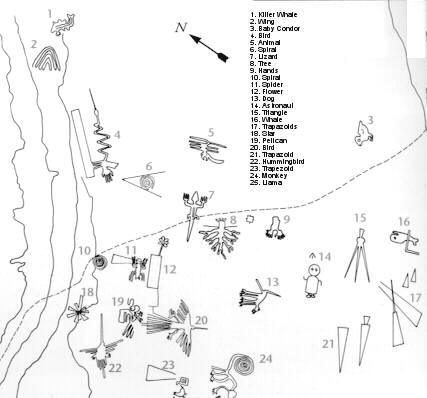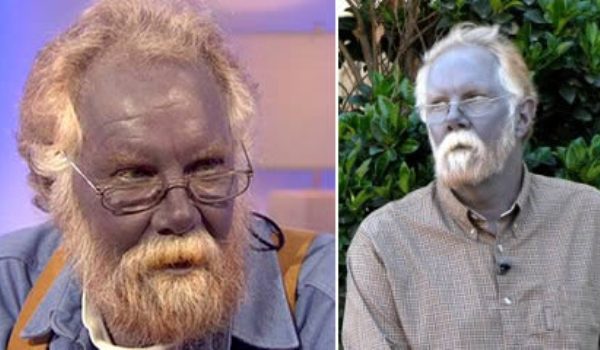The Nazca lines
The Nazca Lines are a series of geoglyphs located in the Nazca Desert, a high arid plateau that stretches more than 80 km (50 miles) between the towns of Nazca and Palpa on the Pampas de Jumana in Peru. Although some local geoglyphs resemble Paracas motifs, these are largely believed to have been created by the Nazca culture between 200 BCE and 700 CE. There are hundreds of individual figures, ranging in complexity from simple lines to stylized hummingbirds, spiders, monkeys, fish, sharks or orcas, llamas, and lizards.
The lines are shallow designs in the ground where the reddish pebbles that cover the surrounding landscape have been removed, revealing the whitish earth underneath. Hundreds are simple lines or geometric shapes, and more than seventy are natural or human figures. The largest are over 200 m across. Scholars differ in interpreting what the lines were for but generally ascribe religious significance to them. "The geometric ones could indicate the flow of water or be connected to rituals to summon water. The spiders, birds, and plants could be fertility symbols. Other possible explanations include: irrigation schemes, giant astronomical calendars, or landing for spaceships."
The dry, windless, stable climate of the plateau has preserved the lines to this day, for the most part. Extremely rare changes in weather may temporarily alter the general designs.
One explanation for the method of construction employed by the Nazca people involves the use of simple tools and surveying equipment. Wooden stakes in the ground at the end of some lines (one of which was found and used to carbon-date all of the figures) support this theory. Researcher Joe Nickell of the University of Kentucky has reproduced the figures using the technology available to the Nazca people of the time and without aerial assistance. With careful planning and simple technologies, a small team of individuals could recreate even the largest figures within days.
The lines were made by removing the reddish-brown iron oxide-coated pebbles that cover the surface of the Nazca desert. When the gravel is removed, the lines contrast sharply with the light-colored earth beneath. There are several hundred simple lines and geometric patterns on the Nazca plateau, as well as over seventy curvilinear animal and human figures. The area encompassing the lines is nearly 500 square kilometers (193 square miles), and the largest figures can be nearly 270 m long (886 feet). The lines persist due to the extremely dry, windless, and constant climate of the Nazca region. The Nazca desert is one of the driest on Earth and maintains a temperature around 25°C (77°F) all year round, and the lack of wind has helped keep the lines uncovered to the present day.
One theory of the purpose of the lines is that the Nazca people's motivations were religious and that the images were constructed so that gods in the sky could see them. Kosok and Reiche advanced one of the earliest reasons given for the Nazca Lines: that they were intended to point to the places on the distant horizon where the sun and other celestial bodies rose or set. This hypothesis was evaluated by two different experts in archaeoastronomy, Gerald Hawkins and Anthony Aveni, and they both concluded that there was insufficient evidence to support an astronomical explanation.
In 1985, the archaeologist Johan Reinhard published archaeological, ethnographic, and historical data demonstrating that worship of mountains and other water sources played a dominant role in Nazca religion and economy from ancient to recent times. He presented the theory that the lines and figures can be explained as part of religious practices involving the worship of deities associated with the availability of water and thus the fertility of crops. The lines were interpreted as being primarily used as sacred paths leading to places where these deities could be worshiped, and the figures as symbolically representing animals and objects meant to invoke their aid. However, the precise meanings of many of the individual geoglyphs remain unsolved as of 2009.
Henri Stierlin, in his 1983 book , linked the Nazca Lines to the ancient textiles found wrapping mummies of the Paracas culture. The lines and trapezes may have been used as giant, primitive looms allowing for the fabrication of the extremely long strings and wide pieces of textile that are typical of the area. In this theory, the figurative patterns (smaller and less common) have only ritualistic purposes.
Some, such as Jim Woodmann, have proposed that the Nazca Lines presuppose some form of manned flight in order to see the figures properly and that a hot air balloon was the only possible available technology. Woodmann actually made a hot air balloon using materials and techniques that he believed would have been available to people at the time, in order to test this hypothesis. The balloon flew, after a fashion, but there is no evidence in support of Nazca-era hot air balloons, and Woodman's work has been rebutted.
What Is Hiding Under The World Famous Nazca Lines In Peru | Blowing Up History
Ed Payne from Lindon, Utah has made some amazing discoveries using Google Earth. An incredible series of ancient lines, circles and shapes has been documented similar to the famous landscape lines in Nazca, Peru except these lines exist on the American landscape. The circular features, and various linear shapes are connected by lines and they appear to be ancient in origin found in very remote locations in Utah. Many of the geoglyphs have been partially hidden by nature and some of the lines have been turned into modern roads. Some long lines continue up to the edges of tall cliffs where they are abruptly cut off by a vertical drop.
According to google earth anomalies some explanation for these lines could be :
tar sands explorations
uranium surveys
Although that the administrator Ed Payne says at the end quote "Conclusions: After extensive research, the origins of the Utah lines remains a mystery and does not have any basis in modern activity. The purpose and meaning behind these mysterious geoglyphs and lines have yet to be determined and the culture that created them remains an enigma."
Of course, a lot of research will go into these recently discovered patterns, so what could we assume about the makers of these patterns?
I believe we have to look at the original inhabitants of these regions.
Which Indian tribes were living in these regions?
The Hopi and the Navajo Indians
The Navajo Nation (Diné Bikéyah in the Navajo language)
The Diné's traditional boundaries are the four sacred mountains, which actually include an area much larger than the present-day reservation. The boundaries of the Nation itself are the Ute Mountain Ute Indian Reservation at the Four Corners Monument and stretch across the Colorado Plateau into Arizona, Utah, and New Mexico.
The Nation surrounds the Hopi Indian Reservation; the Hopi tribe is sometimes known as “Navajo Land Island”.
Hopi mythology
The true Pahana (or Bahana) is the "Lost White Brother" of the Hopi. Most versions have it that the Pahana or Elder Brother left for the east at the time that the Hopi entered the Fourth World and began their migrations. However, the Hopi say that he will return again and at his coming the wicked will be destroyed and a new age of peace will be ushered into the world. As mentioned above, it is said he will bring with him a missing section of a sacred Hopi stone in the possession of the Fire Clan, and that he will come wearing red. Traditionally, Hopis are buried facing eastward in expectation of the Pahana who will come from that direction.
The legend of the Pahana seems intimately connected with the Aztec story of Quetzalcoatl, and other legends of Central America. This similarity is furthered by the liberal representation of Awanyu, the horned or plumed serpent, in Hopi and other Puebloan art. This figure bears a striking resemblance to figures of Quetzacoatl, the feathered serpent, in Mexico. In the early 16th century, both the Hopis and the Aztecs seem to have believed that coming of the Spanish conquistadors was in fact the return of this lost white prophet.[citation needed] However, unlike the Aztecs, upon first contact the Hopi put the Spanish through a series of tests in order to determine their divinity, and having failed, the Spanish were sent away from the Hopi mesas
The Hopi Indians believe all of humanity can be traced to a matriarchal hierarchy. According to the Hopi man was created by woman.The Sumerians believed man was created by a woman.
The male dominant creator is KA.
Taiowa, is the sun God and created the Earth.
Two brothers were given guardianship rights over the Earth.
The Earthlings have access through prayer and meditation to spiritual guides called Alo.
Katchinas (Katsinas) are the messengers of the God KA. They are the spirit teachers of nature.
The Katsinas are descendants of Eototo.
The Hopi name for Pleiades is ChooChooKam
Katsinas by spirit role:
Nan-Ga-So-Hu Chasing Star
Akush Dawn
Danik Guardians in the clouds
Sotunangu Sky
There's also a striking similarity between the gods of the Hopi and the gods of the Sumerians !
The Hopi believe the Creator of Man is a woman. The Sumerians believed the Creator of Man was a woman.
The Hopi believe the Father Creator is KA. The Sumerians believed the Father Essence was KA.
The Hopi believe Taiowa, the Sun God, is the Creator of the Earth. The Sumerians believe TA.EA was the Creator.
The Hopi believe two brothers had guardianship of the Earth. The Sumerians believed two brothers had dominion over the Earth.
The Hopi believe Alo to be spiritual guides. The Sumerians believed AL.U to be beings of Heaven.
The Hopi believe Kachinas (Kat'sinas) are the spirits of nature and the messengers and teachers sent by the Great Spirit. The Sumerians believed KAT.SI.NA were righteous ones sent of God.
The Hopi believe Nan-ga-Sohu is the Chasing Star Katsina. The Sumerians believed NIN.GIR.SU to be the Master of Starships.
The Hopi believe Akush to be the Dawn Katsina. The Sumerians believed AK.U to be Beings of light.
The Hopi believe Danik to be Guardians in the Clouds. The Sumerians believed DAK.AN to be Sky Warriors.
The Hopi name for the Pleaides is ChooChookam. The Sumerians believed SHU. SHU.KHEM were the supreme Stars.
The Hopi believe Tapuat is the name of Earth. The Sumerians believed Tiamat was the name of Earth.
The Hopi call a snake Chu'a. The Sumerians called a snake SHU.
The Hopi use Omiq to mean above, up. The Sumerians used AM.IK to mean looking to Heaven.
The Hopi believe Tuawta is One Who Sees Magic. The Sumerians believed TUAT.U was One from the Other World.
To read more about the creation legend of the Hopi Indians go to indianlegend














